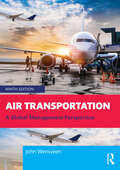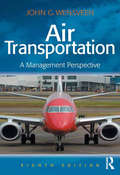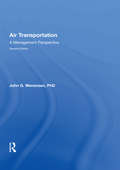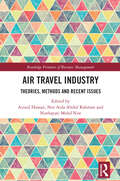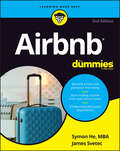- Table View
- List View
Air Transportation: A Global Management Perspective
by John WensveenNow in its ninth edition, Air Transportation: A Global Management Perspective by John Wensveen is a well-proven, accessible textbook that offers a comprehensive introduction to the theory and practice of air transport management. In addition to explaining the fundamentals, the book transports the reader to the leading edge of the discipline, using past and present trends to forecast future challenges and opportunities the industry may face, encouraging the reader to think deeply about the decisions a manager implements. The word "Global" has been added to the subtitle for this edition, reflecting an increased emphasis on worldwide operations, including North America, Latin America/Caribbean, Europe, Asia-Pacific, the Middle East, and Africa. The ninth edition focuses on the "Age of Acceleration," addressing trends related to emerging technologies, such as autonomy, artificial intelligence, augmented reality, virtual reality, 3-D printing, data analytics, blockchain, cybersecurity, etc. New material includes extra information on airport management and operations, air carrier business models, aviation risk, safety and security, and how changing political landscapes impact the aviation industry. Enhanced content is supported by the addition of new chapters and online supplemental resources, including PowerPoint presentations, chapter quizzes, exam questions, and links to online resources. This wide-ranging textbook is appropriate for nearly all aviation programs that feature business and management. Its student-friendly structure and style make it highly suitable for modular courses and distance-learning programs, or for self-directed study and continuing personal professional development.
Air Transportation: A Management Perspective
by John G. WensveenAir Transportation: A Management Perspective by John Wensveen is a proven textbook that offers a comprehensive introduction to the theory and practice of air transportation management. In addition to explaining the fundamentals, the book transports the reader to the leading edge of the discipline, using past and present trends to forecast future challenges and opportunities the industry may face, encouraging the reader to really think about the decisions a manager implements. Written in an easy-to-read, easy-to-understand style, the Eighth Edition modernizes the text focusing on newly emerging management trends, innovative technology, and an increased emphasis on global changes in the industry that will change the future of aviation. New and updated material has been added throughout the text including mini case examples and supplemental presentation materials for each chapter. Air Transportation: A Management Perspective is suitable for almost all aviation programs that feature business and management. Its student-friendly structure and style make it highly suitable for modular courses and distance-learning programs, or for self-directed study and continuing personal professional development.
Air Transportation: A Management Perspective
by John WensveenNow in its Seventh Edition, Air Transportation: A Management Perspective by John Wensveen is a proven textbook that offers a comprehensive introduction to the theory and practice of air transportation management. In addition to explaining the fundamentals, this book now takes the reader to the leading edge of the discipline, using past and present trends to forecast future challenges the industry may face and encouraging the reader to really think about the decisions a manager implements. The Seventh Edition brings the text right up to date with a new opening chapter, titled 'The Airline Industry: Trends, Challenges and Strategies', setting the context for all that follows within the book, and a new section within 'International Aviation' that explores the new airline business models. New and updated material has been added throughout the text and overall presents a more international perspective. Arranged in sharply focused parts and accessible sections, the exposition is clear and reader-friendly. Air Transportation: A Management Perspective is suitable for almost all aviation programs that feature business and management. Its student-friendly structure and style make it highly suitable for modular courses and distance-learning programmes, or for self-directed study and continuing personal professional development.
Air Travel Industry: Theories, Methods and Recent Issues (Routledge Frontiers of Business Management)
by Azizul Hassan Nor Aida Abdul Rahman Nurhayati Mohd NurAs the air travel industry begins to emerge from the COVID-19 restrictions, new research must be undertaken to survey the changing business landscape. This book examines existing air travel literature, illustrates the current theories in the field, and suggests research methods for integrating them in fieldwork. The book begins by surveying the landscape of air travel research and examining key theoretical frameworks such as grounded theory, institutional theory, prospect theory, and the theory of planned behavior. It then explores when qualitative and quantitative research methods are appropriate for use in air travel research, and how they can be applied successfully. Gathered contributors from Southeast Asia and the Middle East highlight some of the latest issues, including the impacts of COVID-19 on airfreight, airline catering, and passenger perceptions of security and safety. Future directions for research are also proposed. This book will appeal to researchers and postgraduate students in the fields of air transport or aviation management, tourism marketing, and consumer behavior.
Air Travel Partnerships: How to Create Greater Value through Collaboration
by Nawal K. TanejaWhile change in the aviation sector is hardly a new phenomenon, going forward the rate of change will accelerate due to the emergence, convergence, and intersection of powerful internal and external forces. To deal with the accelerating change in the marketplace, stakeholders in the travel ecosystem need to deepen collaboration that is productive to (1) building adaptable, resilient, and lean businesses, (2) achieving growth and innovation, (3) elevating traveler experience to a much higher level, and, at the same time, (4) reducing the impact on the environment.Undoubtedly, while some innovations implemented by different aviation business sectors—to become more adaptable, more resilient, and leaner as well as to improve customer experience—have been adding some value, the innovations being introduced have been transactional, fragmented, and incremental. What is needed is a step change in proactive collaboration among different stakeholders in the air travel ecosystem at the holistic level, to cocreate value for travelers in terms of experience (relating to simplicity, convenience, and speed) and for businesses to adapt in order to reduce costs and increase profit margins.This book focuses on four types of organizations within the air travel sector: airlines, airports, aircraft manufacturers, and travel intermediaries. It provides a framework, tools, and insights to enhance collaborations by design in an age of increasing uncertainty.Air Travel Partnerships is essential reading for all executives and senior managers within airlines, airports, and air transport supporting industries.
Air Your Nightmares: How Do You Discuss Risk Without Risking the Deal?
by Danny Ertel Mark GordonRisk is an ordinary and necessary part of any negotiation process and should be treated as such. This chapter discusses how to express concerns without creating an adversarial climate.
Air, Food, and Water: Your Revenue Model--Developing a Revenue Model that Paying Customers Will Support
by Randy Komisar John MullinsThere are five elements of any company's business model that determine whether a business or organization can survive and prosper: revenue, gross margin, operating expenses, working capital, and investment. Revenue is to any business--and to most other organizations, too--as air, food, and water are to mankind--it is fundamental to survival. Without revenue, a business is as lifeless as a plant without water. This chapter examines six questions that underlie every revenue model and demonstrates how three companies--Google, Silverglide Surgical Technologies, and China's interactive gaming leader, Shanda Interactive--identified a customer problem they could resolve and developed healthy revenue models that paying customers were willing to support. The authors' goal? To help you do the same. This chapter was originally published as Chapter 3 of "Getting to Plan B: Breaking Through to a Better Business Model."
AirFox (A): Embracing the Blockchain and an ICO
by Jeffrey J. Bussgang Nathaniel Schwalb Edward B. BerkCase
AirFox (A): Embracing the Blockchain and an ICO
by Jeffrey J. Bussgang Nathaniel Schwalb Edward B. BerkCase
Airbnb
by Evan Richardson Joseph B. LassiterBrian Chesky, Joe Gebbia, and Nathan Blecharczyk, the three founders of Airbnb, an online private accommodation rental market, stared at each other across the kitchen table in their San Francisco apartment. It was March of 2009. A single sheet of paper sat on the table in front of them. The three founders were on the verge of finishing the three month program at YCombinator (YC), a business accelerator located in Mountain View, CA.
Airbnb (A)
by Benjamin Edelman Michael LucaAfter widely-publicized complaints of destructive guests and unreliable hosts, online apartment rental site Airbnb explores mechanisms to facilitate trust between guests and hosts. Flexible online reputation systems can collect and share information with ease, but Airbnb must decide which information guests and hosts should have to provide and how much flexibility each should have in selecting whom to do business with. A full-featured system could provide all the information users have been requesting, but would it be too complicated for routine use?
Airbnb During the Covid Pandemic: Stakeholder Capitalism Faces a Critical Test
by Benjamin C. Esty Allison M. CiechanoverAs the covid pandemic spread in early 2020, global travel ground to a halt. For Airbnb, the San Francisco-based platform for renting accommodations, the impact was both swift and severe as revenues plummeted more than 70% over the prior year. Responding to the sudden downturn was a challenge for CEO Brian Chesky and his leadership team because the firm had a adopted a stakeholder model with five key constituents: guests (renters), hosts (landlords), employees, communities and shareholders. While all five groups could benefit in the long-term if the firm succeeded, it was less clear how they should balance the potentially conflicting demands in the short-term particularly given the mounting losses. For example, in the face of travel restrictions, Airbnb could support guests by requiring hosts to refund deposits or could support hosts by allowing them to keep deposits. Similarly, should Airbnb use existing cash to maintain employment levels or downsize to protect capital providers? In the highly uncertain environment that existed in April 2020, Chesky and his team had to make many critical decisions with little precedent and limited information to guide them. As one of the first Silicon Valley "unicorns" to adopt a stakeholder business model, the world would be watching to see what they did, how they did it, and why.
Airbnb Emerges from the Pandemic: Lessons for Stakeholder Governance (B)
by Benjamin C. Esty Allison M. CiechanoverAs the COVID pandemic spread in early 2020, global travel ground to a halt. For Airbnb, the San Francisco-based platform for renting accommodations, the impact was both swift and severe as revenues plummeted more than 70% over the prior year. Responding to the sudden downturn was a challenge for CEO Brian Chesky and his leadership team because the firm had adopted a stakeholder model with five key constituents: guests (renters), hosts (landlords), employees, communities and shareholders. While all five groups could benefit in the long-term if the firm succeeded, it was less clear how they should balance the potentially conflicting demands in the short-term particularly given the mounting losses. For example, in the face of travel restrictions, Airbnb could support guests by requiring hosts to refund deposits or could support hosts by allowing them to keep deposits. Similarly, should Airbnb use existing cash to maintain employment levels or downsize to protect capital providers? In the highly uncertain environment that existed in April 2020, Chesky and his team had to make many critical decisions with little precedent and limited information to guide them. As one of the first Silicon Valley "unicorns" to adopt a stakeholder business model, the world would be watching to see what they did, how they did it, and why.
Airbnb For Dummies
by Symon He James SvetecMake extra money—and your guests extra happy—with Airbnb! You’ve got that spare tower, mansion, apartment, couch, or perhaps even treehouse (really—there are more than 2,400 treehouses listed on Airbnb). You’re a polite, clean, and tolerant host. And you want to make some money. Congratulations, you’re fully qualified to become part of the Airbnb revolution! Whether you’re looking to break into the business, or have already started and are researching ways of making your guests feel even more pampered as you grow your reputation and income, Airbnb for Dummies is the perfect venue for you. And this applies whether you currently own property or not! Sit back in your lounge recliner and let the owners and founders of Learnairbnb.com show you the ins and outs of the short-term rental boom that connects hosts with travelers looking for more economical and personal travel experiences across the world. Sip a refreshing drink as you learn how to manage the day-to-day—from maintaining listings to keeping things clean for your guests—and how to maximize and increase your profits. Make an attractive listing Perfect your pricing Profit without a property Create amazing guest experiences So, get hold of a copy, read it in your favorite spot, and watch as the money and excited guests beat a path to your door!
Airbnb For Dummies
by Symon He James SvetecTurn to the most-trusted guide to get started on your Airbnb adventure Airbnb For Dummies is here to help you prep your property and post your first listing on the wildly popular short-term rental site. Even if you don’t have a house, you can become an Airbnb host. A spare room at your place, a camper, a boat, a treehouse, a castle—you can turn just about anything into an Airbnb and earn additional income hosting guests. You can even offer tours around your hometown. This comprehensive resource helps you make your goals a reality, with details on how to get set up and navigate the platform and where to turn for info on local short-term rental rules, plus all the post-pandemic changes to travel and to Airbnb’s policies. Learn to attract adventurers from far and wide, with help from For Dummies experts. Decide whether becoming an Airbnb host is right for you Create an appealing listing on the Airbnb site and attract guests Host experiences and ensure the health and safety of guests Get positive reviews and improve your property’s visibilityThis book is especially for you, the first-time Airbnb host in need of a guide for creating a listing, keeping up a property, and attracting guests.
Airbnb Listing Hacks: The Complete Guide To Maximizing Your Bookings And Profits
by Alex WongAirbnb has become something of a phenomenon recently. Every day, in every town on the planet, homeowners are making money by renting out their spare rooms to travelers. But with more and more people catching on, it's becoming increasingly difficult to stand out from the crowd. <p><p> This new book, Airbnb Listing Hacks: The Complete Guide to Maximizing Your Bookings and Profits can make all the difference in helping you stand out. <p> Years of helping hosts to optimize their listings, along with all the techniques required for success and how to avoid the common mistakes most hosts make, are crammed into this informative asset.
Airbnb Secrets: Earn $5000 A Month Posting Your Pad
by Sebastian RitterLooking to make some extra cash by renting out that spare room? Or maybe you want to dive into a full-on investment property! Making money through property rentals has never been more accessible and this guide will tell you everything you need to know about how to get started, how to be successful, and how to set yourself apart from the rest.
Airbnb in Amsterdam (A)
by Emer Moloney Vincent Dessain Mitchell WeissIn February 2014, Amsterdam became the first city to issue new regulations specifically to allow home-sharing. Airbnb's Molly Turner, Global Head of Civic Partnerships; her colleagues at the San Francisco based home-sharing platform; and her counterparts in Amsterdam's city leadership now had to make the new rules function well. By the summer of 2014, the question of how exactly to do that remained unsettled. A Memorandum of Understanding (MOU) that Airbnb was negotiating with Amsterdam officials to supplement the new home-sharing rules was not materializing. Turner was hearing that the company's proposed commitments that spanned education on regulations, enforcement-assistance, and tax collection might not be enough to secure what would be Airbnb's broadest partnership with any city anywhere. Nanette Schippers was Amsterdam's Advisor on the Sharing Economy in its Innovation Office, and its lead at the negotiating table that summer. She was worried by the stand-still, too. A primary reason for the impasse in the negotiations was that Amsterdam wanted access to Airbnb's data in order to enforce the new laws more easily, while Airbnb sought to protect user privacy. For Airbnb, privacy, precedents and platform principles were at stake. For Amsterdam, it was a matter of making sure that the historic city did not become "Venice, or Florence, or 'Disneyland'"; that it wasn't overrun by visitors and that locals weren't crowded out. Could the two parties now find dry land?
Airbnb in Amsterdam (B)
by Emer Moloney Vincent Dessain Mitchell WeissIn December 2014, the City of Amsterdam and Airbnb announced an MOU to promote responsible home-sharing and to simplify the payment of tourist tax for hosts in the City. It was the most comprehensive agreement that Airbnb had with any city in the world. It's final provision read, "The parties trust that theirs will be a fruitful cooperation." However, both sides were uncertain about how the agreement would be received. Molly Turner, Airbnb's Global Head of Civic Partnership and Tanja de Coster, an Airbnb lawyer in Europe, were unsure how Airbnb's hosts would react. As were their Airbnb colleagues. Laila Frank, who had been an advisor to the Deputy Mayor in Amsterdam, heralded the reputational gains from the agreement for the city, "We were worldwide news. In that way it worked out really well." But she acknowledged that there were also skeptical points of view. "The only immediate result was the tax agreement, which we were really happy about. But the rest had to be proven."
Airbnb, Etsy, Uber: Acquiring the First Thousand Customers
by Thales S. Teixeira Morgan BrownBy 2016, two-sided online platforms (or marketplaces) were pervasive among the highest growing internet startups around. These marketplaces sought to match suppliers of assets for rent, physical products or services with customers demanding them. Among the most notable two-sided platforms in terms of their tremendous early growth were Airbnb, Etsy and Uber. They offered short-term property rentals, handcrafted goods, and car rides, respectively. As two-sided markets grew to scale, network effects kicked in as more consumers bred more suppliers and vice versa. But how did these platforms acquire their first customers, at the time when they had so few providers? How exactly did they go about acquiring their first thousand customers?
Airbnb, Etsy, Uber: Growing from One Thousand to One Million Customers
by Thales S. Teixeira Morgan BrownBy 2016, two-sided online platforms (or marketplaces) were pervasive among the highest growing internet startups around. These marketplaces sought to match suppliers of assets for rent, physical products or services with customers demanding them. Among the most notable two-sided platforms in terms of their tremendous early growth were Airbnb, Etsy and Uber. They offered short-term property rentals, handcrafted goods, and car rides, respectively. As two-sided markets grew to scale, network effects kicked in as more consumers bred more suppliers and vice versa. But how did these platforms ride the second wave of growth? How did they grow from one thousand to one million customers?
Airborne Express
by Jan W. RivkinIn the wake of a highly successful quarter, senior managers of Airborne Express, the third largest player in the express mail industry, review the firm's competitive position. Airborne has survived, and recently prospered, in an industry with significant economies of scale even though it is much smaller than industry giants Federal Express and United Parcel Service. The case challenges students to understand Airborne's unusual position. Detailed data allow students to analyze Airborne's relative cost position, the fit among its activities, the differences between Airborne and its rivals, and the evolution of its industry. Using these analyses, students make recommendations concerning the firm's pricing policy, its globalization efforts, and a partnership with a related company. Designed to be taught in a course on business-unit strategy.
Airborne Wind Energy: An Overview of the Technological Approaches (Green Energy and Technology)
by Uwe AhrensThis book shows possible solutions to how a profitable energy supply can be implemented with almost no population resistance. Worldwide, more than 80 % of our energy needs are still covered by fossil fuels. Under these circumstances, can climate change still be stopped? Essential technologies for usage of wind energy with an emphasis on high-altitude wind utilization are presented. Airborne wind energy is one of the most promising technologies to enable a renewable energy turnaround in an economical way. The main problem of conventional renewable energy is the insufficient availability. To ensure a 100 % supply of renewable energy, enormous and very expensive storage capacities would have to be built up. How we can cover our entire energy needs (electricity, mobility and heat) in the future without fossil fuels, without risking the competitiveness of our economy, is shown in this book.
Airbus A3XX: Developing the World's Largest Commercial Jet (A)
by Michael Kane Benjamin C. EstyIn July 2000, Airbus Industries' supervisory board is on the verge of approving a $13 billion investment for the development of a new super jumbo jet known as the A3XX that would seat from 550 to 1,000 passengers. Having secured approximately 20 orders for the new jet, the board must decide whether there is sufficient long-term demand for the A3XX to justify the investment. At the time, Airbus was predicting that the market for very large aircraft (VLA), those seating more than 500 passengers, would exceed 1,500 aircraft over the next 20 years and would generate sales in excess of $350 billion. According to Airbus, it needed to sell 250 aircraft to break even and could sell as many as 750 aircraft over the next 20 years. This case explores the two sets of forecasts and asks students whether they would proceed with the launch given the size of the investment and the uncertainty in long-term demand.
Airbus A3XX: Developing the World's Largest Commercial Jet (B)
by Michael Kane Benjamin C. EstySupplements the (A) case.
